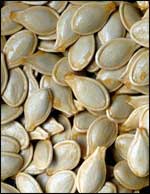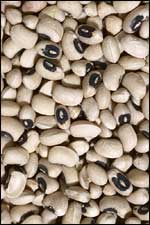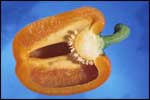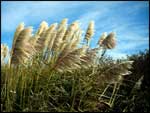Seeds
Most plants produce seeds of some kind, but not all seeds are alike. Nature not only has given them different sizes, shapes, and colors, but also has packaged them in any unique ways. Some are found inside soft, fleshy coverings. Who hasn’t noticed seeds in apples, oranges, peaches, tomatoes, and watermelons? However, have you ever seen the seeds in a banana? Its tiny brown seeds are found inside the soft fruit, and most of us eat them without even noticing they are there.

Some seeds are enclosed in hard shells. Nuts are a good example of this type of unique packaging. Almonds, walnuts, and pecans are opened easily with a nutcracker, but the tough outer shell of a coconut is a different matter. It may take several blows with a hammer to crack the outer shell, and then you still will need to crack the fiber-covered inner shell to get to the milk and raw coconut.

Pods are another packaging method used by plants. Beans and peas, which are actually seeds, grow in this manner. When the seeds are fully developed, the pods are split open and the peas and beans removed. Sometimes pods are harvested in the early stages of growth, and we eat them along with the partially developed seeds. Green beans and okra pods are such examples.
Had you ever stopped to think about how many different kinds of seeds there are? They can be round, flat, oblong, smooth, wrinkled, or fuzzy; and they may be yellow, brown, red, green, other colors, or even combinations of colors. As different as they may be from each other, all seeds are alike in three ways: in every seed there is an embryo (EM-bri-o) or baby plant; each seed contains some kind of food for the young plant; and every seed has a protective covering around the young plant and its food.

One of the truly amazing
things about a seed is that
the food stored in it for
the new plant remains usable
even though the new growth
does not start for weeks,
months, or even years. To
give you an extreme example,
researchers have been able
to germinate, or sprout,
grain seeds found in the
ancient Egyptian tombs.
However, since the dormant
(suspended or inactive)
period varies with different
seeds, the amount of time
that can pass between seed
formation and successful
planting will depend upon
the type of seed and the
conditions to which it is
exposed.
If you would like to take a closer look at a seed to study its parts and observe its development, you might find the lima bean an interesting subject. Although originally grown in a pod, the large dried bean is now in its true seed form. Its outer surface is covered with a hard protective seed coat. If you soak this lima bean seed in water for a few hours, the seed coat will soften and you will be able to peel it off. Under the seed coat you will find two thick, fleshy parts that are the food storehouses for the embryo plant. Carefully lift one away from the other and you will see the tiny plant nestled between them.

Now that you have proved to yourself that the seed really does contain a tiny plant, you might want to watch a lima bean plant grow and develop naturally. To do this, plant a few lima beans in a glass of moist soil or sand, being sure to place them against the glass so they can be seen. The moisture in the soil will soften the seed coat so the tiny plant can break through. (Soaking the seed before planting usually speeds sprouting time.) The fleshy parts will provide food for the plant until its root system and leaves are developed enough for it to begin to manufacture its own food.
Under natural conditions, the life of a seed is a hazardous one. Only a few survive to produce new plants. In addition to the many seeds eaten by humans, wildlife species also take their share. Seeds that escape being eaten must manage to sprout in the soil. If the soil is too dry, the seed plant will die, and if it is too wet, the seed may rot. Weather that is too hot or too cold also will destroy the young plant in the seed. To ensure that some seeds will survive, plants produce many more than are needed. For this, wildlife and humans both can be thankful.

Think what it would be like if there were no seeds for us to eat. Our diets would be drastically changed. There could be no breads, cakes, pies, or other bakery products since the flour used to make them comes from wheat, barley, rye, or other grain seeds. Corn, peas, beans, and nuts also would be eliminated. Coffee and cocoa drinkers would have to switch to tea since coffee and cocoa bean seeds would not exist. Pepper and mustard are seasonings made from ground seeds, so we would have to learn to do without them too.
If we also eliminated the seed coverings, we would have to give up fruits, cucumbers, squash, pumpkins, tomatoes, and that old favorite, catsup. Lemonade, orange juice, and apple cider also would disappear from our drink list. Mealtimes would certainly seem strange without all our seed favorites, and Thanksgiving dinner just wouldn’t be the same without cornbread dressing and pumpkin pie.
Whether they provide food for humans, wildlife, or new plants, aren’t you glad seeds exist in their many forms?
Ilo
Hiller
1983 Seeds. Young
Naturalist. The Louise
Lindsey Merrick Texas Environment
Series, No. 6, pp. 72-73.
Texas A&M University
Press, College Station.